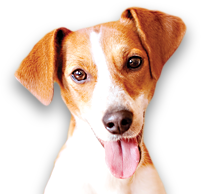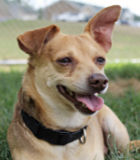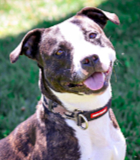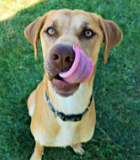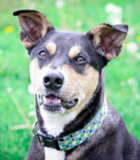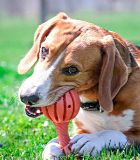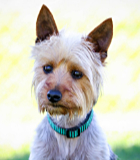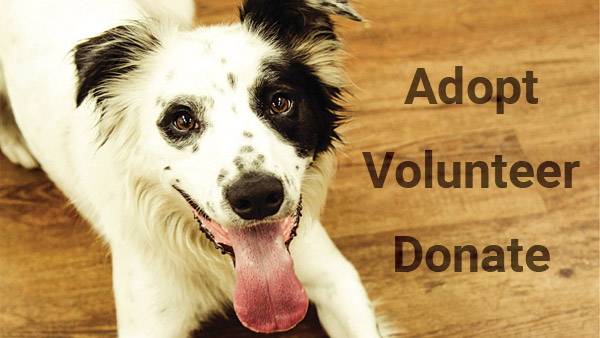Bathing Your Dog
- This topic has 0 replies, 1 voice, and was last updated 13 years, 10 months ago by
Mackenzie’s Admin.
-
AuthorPosts
-
June 11, 2010 at 6:41 pm #527
Mackenzie’s Admin
MemberBathing Your Dog
Most dogs don’t mind getting and staying dirty. In fact, many seem thrilled to find stinky stuff to roll in—like dead animals. Most pet parents, on the other hand, would rather not share their lives with smelly or dirt-encrusted dogs. So here’s how to give your dog a good scrubbing, using techniques that make the process as easy and stress-free as possible for you and your pet.Bath Time’s the Best!
No matter what age, size, sex or breed of dog you have, you can make bathing a pleasant part of your dog’s life if you do two things:Teach your dog to associate bathing with things he loves.
Take it slow and easy.Associate Bathing with Good Things
Many dogs find bath time unpleasant—and who can blame them? It involves being restrained, soaked with water (which some dogs really dislike), slathered in scented suds and handled in various, sometimes uncomfortable ways. However, you can help your dog learn to tolerate—and maybe even enjoy—bathing.The secret is to teach your dog that bathing is always followed by things he loves. If your dog learns that bath time reliably leads to wonderful stuff—like special treats, brand-new chew toys, the start of a favorite game, a walk in the park or dinnertime—he’ll soon learn to feel much better about it. And if he feels much better about getting a bath, he’ll behave better too, which will make bath time easier for both of you. So whenever you bathe your dog, help him to associate bath time with things he enjoys. Right after putting him into the tub, give him a tasty treat, like a small bite of chicken or cheese. If your dog seems nervous about running water, give him a treat right after turning on the tap. After toweling him off, immediately invite him to play a rousing game of tug or give him a handful of his favorite treats. With repetition, your dog will probably decide that getting a bath is fun, not frightening or stressful.
Take It Slow and Easy
Take time to gradually introduce your dog to bathing. Before giving him a bath, spend a couple of days just taking him into the bathroom, putting him in the tub, giving him a few tasty treats and then taking him out again. Spend a few more days turning on the water or the sprayer before giving your dog his treats—but don’t give him an actual bath yet. You’re just getting him used to the sensations and sounds involved in bathing. After two to five days of getting your dog used to the bath-time scenario, you can give him a real bath. (For step-by-step bathing tips, please see below.) Remember to keep delivering treats throughout the process and right after you finish bathing.It’s also helpful to pay attention to your own voice and body language. In order for your dog to be relaxed and calm during bathing, you’ll need to be relaxed and calm, too. When it’s time for a bath, approach him calmly and speak quietly. Continue to talk to him in a casual voice and praise him throughout the bath. When you apply shampoo and lather up your dog, massage his body as gently as possible, handle his paws carefully and try to avoid causing him physical discomfort.
About Puppies
If you get your puppy used to regular bathing now, bathing him as an adult will be a breeze. Follow the guidelines above with your puppy. The same ideas apply. Try to focus on associating bath time with treats, toys and games, and on slowly and gently introducing your puppy to the sights, sounds and sensations of bathing. Bring some toys into the tub, encourage your puppy to play with the bubbles and make the bath seem like playtime.It’s also worthwhile to get your puppy accustomed to other kinds of grooming and handling. Take time every day to touch your puppy all over his body. Handle his feet and toes, open his mouth and look at his teeth, examine his ears, brush his fur, carefully trim his nails, lift and handle his tail, and gently restrain him in your arms for a few seconds at a time. Immediately after touching or handling, give your puppy his favorite treat or play with him. Just like with bathing, your goal is to convince your puppy that people restraining and handling him result in good things. If you can build your puppy’s positive feelings about grooming when he’s young, handling and grooming will be much easier for you both throughout his life. Please see our articles, Grooming Your Dog and Trimming Your Dog’s Nails, for more detailed tips.
Time for a Bath
Because of their activities, breed types, or individual skin or coat types, some dogs need baths more often than others. For example, some dogs’ coats just get oily quickly, regardless of their outdoor activities. Other dogs spend lots of time outdoors and get dirty fast. However, if you bathe your dog too often, you might cause skin irritation and flaking, so be sure to check with your dog’s veterinarian to find out how frequently you should give your dog baths.Before You Start
First things first: you’ll need to find a good shampoo. Pet stores carry an array of shampoos and conditioners. The best way to choose one is to consult your dog’s veterinarian or a professional groomer. Choose a mild soap. You do want to rid your dog of dirt and odor, but you don’t want to strip natural oils from his fur and skin. Avoid using human shampoo, which can dry out your dog’s skin and lead to excessive scratching.
Brush your dog’s coat to remove loose fur and tangles. This can reduce the amount of fur your dog sheds during the bath and prevent additional tangles, which can be painful to comb out.Avoid calling your dog to come to you when you’re about to bathe him. Coming when called should always result in rewards for your dog. If you call him, he comes running and then something unpleasant happens to him (like a bath), he’ll learn not to come. Instead of calling your dog, just approach him calmly when you’re ready to bathe him. Gently pick him up and carry him to the bathing area or use a leash to lead him there.
Into the Tub
Before you get started, gather all your supplies: shampoo, conditioner, treats and a towel. Place a rubber bath mat or a thick towel in the tub to prevent your dog from slipping and sliding when he gets in. This will prevent injury and help him feel more secure during the bath. When you’re ready, get your dog and lead or carry him to the bath area. Turn on the water and test the temperature before putting your dog into the tub. Make sure it’s lukewarm—not too cold and not too hot. Then lift your dog into the tub. If he’s too heavy, show him a tasty treat, such as a small bite of chicken, cheese or hot dog, and toss it in the tub. He might hop in to get it. If he doesn’t, you’ll need to teach him a cue (a command) so that you can ask him to jump in and out of the tub.Teaching Your Dog to Get In and Get Out
You’ll teach your dog two cues: “Get in” and “Get out.” Start by preparing some tasty treats, such as small pieces of chicken, cheese or hot dog. Take your dog to a quiet area (not the bathroom), and find something your dog can step or easily hop into. You can use anything that’s large enough for him to comfortably stand in. An empty cardboard box will work well. You can trim the sides down so that it’s easy for your dog to step into and out of it.Show your dog a treat.
Say your cue, “Get in.”
Toss the treat into the box. When your dog steps into the box, say “Good!” and give him another treat.Then say “Get out,” and clap your hands and move away to encourage your dog to step out of the box. You can praise him when he does, but you don’t need to treat him. It’s best to convince him that it’s the most fun to get into the box (and later the tub).
Repeat these steps about 10 times. Take a break for a few minutes, and then practice another set of 10 repetitions. After your second set, end the training session. Practice the steps above for two or three days. Aim to have a couple of training sessions per day.Now that your dog has practiced following a treat into the box, ask him to go in before rewarding him with the treat.
To warm up, do a couple of repetitions just like you did before—throwing the treat into the box so that your dog follows it. Then change the rules a little.
Say “Get in,” and point to the box instead of throwing a treat into it. (When you point to the box, it might help to move your arm like you did when tossing a treat into the box. A similar motion can remind your dog what you want him to do.)
Wait until your dog goes in. When he does, praise him and immediately give him a couple of treats while he’s still in the box.Then say “Get out,” and encourage your dog to come out of the box.
Do 10 repetitions and take a short break. Repeat the exercise 10 more times, or until your dog knows the game and readily steps in and out of the box when you ask him to. Practice the steps above for two or three days. Aim to have a couple of training sessions per day.Now you’re ready to move your training sessions to the bathroom. Before you start, put a rubber bath mat or a thick towel in the tub, and a bath mat outside the tub, so that your dog doesn’t slip as he jumps in or out. Repeat the steps above, but this time use your cue to ask your dog to jump in and out of the tub instead of the box.
Say “Get in,” and point to the tub. (The first few times you give the cue, you might need to toss a treat into the tub to show him what he’s supposed to do.)
When your dog jumps in the tub, praise him lavishly and immediately give him a few treats.
Say “Get out,” and encourage your dog to jump out of the tub.
Repeat the steps above 10 times. Take a short break, and then do another set of 10 repetitions. After your second set, end the training session and give your dog an extra-special treat or chew bone, or play his favorite game with him. You want him to learn that great things happen when he plays the tub game! Practice the steps above for about a week, with a couple of training sessions a day if possible.When your dog confidently jumps in and out of the tub when you ask him to, try using the cue at bath time. Continue to reward your dog right after he jumps into the tub and right after the bath is over.
Wet, Lather, Rinse and Dry
Before turning on the water, you can gently place a large cotton ball in each of your dog’s ears to keep them free of moisture. (If your dog seems upset by having cotton balls in his ears, skip this step. Just be sure to avoid spaying or pouring water into your dog’s ears.) First, thoroughly wet your dog. You can use a cup or a small bucket to pour water over his coat—or you can use a sprayer that attaches to your showerhead or faucet. It’s best to purchase one made for bathing dogs, such as the Rinse Ace® Pet Shower Deluxe. When your dog is completely wet, apply shampoo from the neck down and gently massage it into his coat. As you’re lathering, touch your dog all over. If you make a habit of doing this, you’ll become very familiar with his body and be able to detect any changes that might require veterinary attention, like new lumps or bumps, inflammation of your dog’s skin, ears or eyes, or any painful responses he might have to touching.Be careful to avoid getting water or shampoo into your dog’s ears, eyes and mouth. Use a damp washcloth to wipe any dirt from his muzzle, head, ears and eyes. After shampooing your dog, rinse his coat thoroughly. Most dogs’ coats are thicker than human hair, so it takes some time working your fingers through the coat to ensure that all the shampoo is out. If shampoo residue is left in, it can make your dog itch. After rinsing, you can use a dog conditioner to moisturize your dog’s skin and minimize tangles if he has long hair. After the bath, it’s time to thoroughly dry your dog. Pet stores sell super-absorbent towels that you might find work better than your regular towels. Some pet parents prefer to use a blow dryer to dry their dogs. If you’d like to try it, you’ll need to help your dog get used to the way a blow dryer feels and sounds before you use one. Be sure to use the blow dryer on a lower heat setting so that you don’t burn or dry out your dog’s skin.
A word of warning: it’s normal for dogs to rub themselves on the carpet, furniture or the ground after a bath. If you’re concerned about your couch getting wet or your dog getting covered in lawn clippings or dirt, keep him confined in a safe area like your kitchen, until he’s totally dry.
The Post-Bath Party
Now that you’ve finished bathing your dog, celebrate to make sure your dog thinks that bath time always leads to fun for him. Right after the bath, feed him a few delicious treats and praise him enthusiastically. Then, if he’s interested, you can play one of your dog’s favorite games, such as tug or fetch.Bathing Alternatives
If you can’t or don’t want to use your bathtub to bathe your dog, try one of the following ideas instead:If you’ve got a medium-sized or larger dog, you can bathe him in the shower. It’s much easier for dogs to step into showers without tubs.
If it’s warm enough, try bathing your dog outside. You can use a plastic kiddy pool or a regular hose. If your dog loves to chase a stream of water coming from a sprayer, you can incorporate that game into bath time. Spray water into the pool and let your dog jump in to chase the stream. After a minute or two of fun, shampoo and rinse your dog. Then, after the bath, you can play with the sprayer again to reward your dog.If you have a small dog, you can bathe him in a kitchen or utility sink. You won’t have to bend over, and your dog won’t have to get into a big bathtub, which might scare him. You can use the kitchen-sink sprayer to conveniently wet and rinse your dog!
You can purchase a special tub made specifically for bathing dogs, such as the Scrub-a-Dub Dog Tub. Dog tubs usually include a leash clip to restrain your dog, a hose and a showerhead attachment or sprayer. Some are designed to make it easy for your dog to get into and out of the tub. Many are portable, so you can bathe your dog anywhere you like.
Some pet-care businesses, such as boarding kennels, day cares and groomers, offer do-it-yourself dog wash stations. Usually, you just have to bring your dog. The business provides shampoo, conditioner and towels. The self-serve tubs include sprayers or hoses, and they often have ramps, so your dog can easily walk into the bathing area.
If your dog really dislikes bathing, only bathe him when absolutely necessary. Instead of getting him wet, brush him daily and use a damp cloth to wipe stubborn dirt off of his fur and paws. You can also try using a powder, spray or foam “dry shampoo” on your dog, such as Waterless Bath™ by Bio-Groom®. Just apply the shampoo to your dog’s coat and then brush him. No rinsing is needed.Calling in the Professionals: How to Choose a Groomer
Some people prefer to hire a professional groomer because they don’t have the time, tools or experience to properly groom their dogs. Most groomers’ services include bathing, cutting and shaping fur, combing and brushing, mat removal, clipping nails and cleaning ears. If a groomer is the right option for you and your dog, ask for recommendations from your dog’s veterinarian and your friends or family. You can also ask dog trainers, boarding kennels, animal shelters or pet supply stores for their recommendations. Before taking your dog to a grooming facility, check the Better Business Bureau for complaints against the establishment. Visit the facility before making an appointment for your dog, and take note of the building and the staff.Does the place look and smell clean?
Is the staff friendly and knowledgeable?
Do they handle their dog clients gently and respectfully?
Where are animals kept before and after grooming?
Will the groomer allow you to watch a grooming session? (You should be permitted to do this.)
Does the groomer ask for your pet’s vaccine records and emergency contact information? (She should.)
Does the groomer use any kind of medication to sedate dogs? (She shouldn’t.)
Does the facility seem too loud, too hot, too cold or generally uncomfortable?
When you choose a groomer and make your dog’s first appointment, be specific about telling the groomer what you do and do not want her to do to your dog. If you think your dog might find a loud hairdryer frightening, ask the groomer to let him dry naturally. If your dog doesn’t like to be left alone, ask the groomer to contact you as soon as she’s finished grooming him. Also tell the groomer to skip painful and unnecessary procedures, such as cutting your dog’s nails too short and “plucking” (pulling out tufts of the undercoat by hand).After your dog’s first appointment with a groomer, take note of his demeanor. Some stress is normal. Your dog has just had a new and strange experience. However, if he seems upset or frightened, consider trying another groomer or learning to take care of grooming tasks yourself, in the comfort of your own home.
If Your Dog Already Fears or Dislikes Bathing
Some dogs are fearful or aggressive when their pet parents attempt to bathe or handle them. Signs of fear or aggression include trembling, trying to get away or hide, drooling, panting, whining, freezing, staring, growling, snarling, snapping and, of course, biting. If your dog does any of these things when you try to bathe him, you need the professional help of a Certified Applied Animal Behaviorist (CAAB or Associate CAAB) or a veterinary behaviorist (Dip ACVB). If you can’t find one of these professionals in your area, you may be able to find a Certified Professional Dog Trainer (CPDT). If you elect to hire a CPDT, be sure to determine whether she or he has professional training and experience in treating fear and aggression, which isn’t required for CPDT certification. Please see our article called Finding Professional Help to locate a qualified expert near you.What NOT to Do
Do not physically punish or yell at your dog if he resists bathing. Doing this will only make him feel worse about the activity, and it will probably worsen his behavior.
Do not force your dog to submit to bathing if he’s obviously frightened. Contact a professional behavior expert for help instead. (Please see our article, Finding Professional Help.) -
AuthorPosts
- You must be logged in to reply to this topic.

